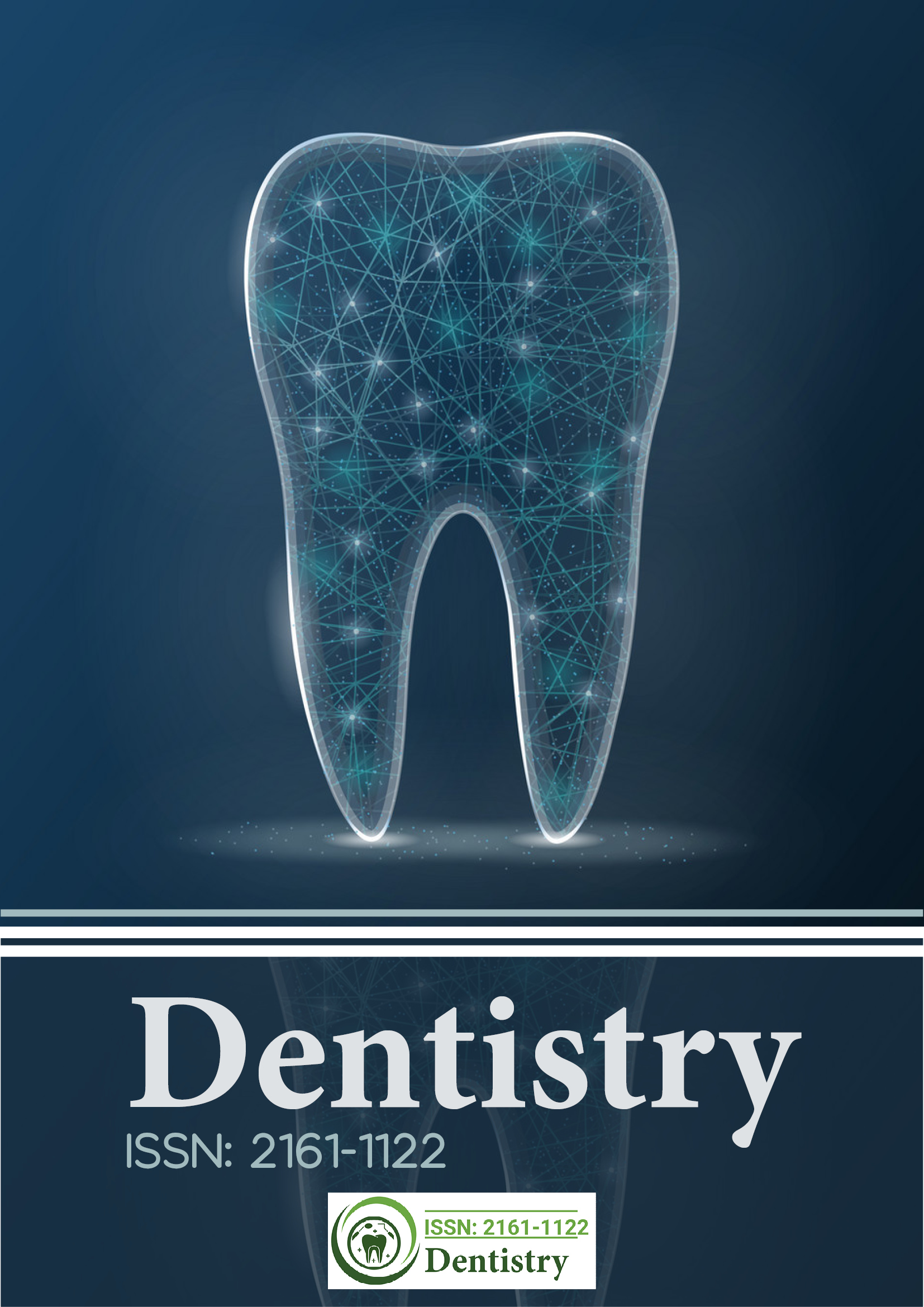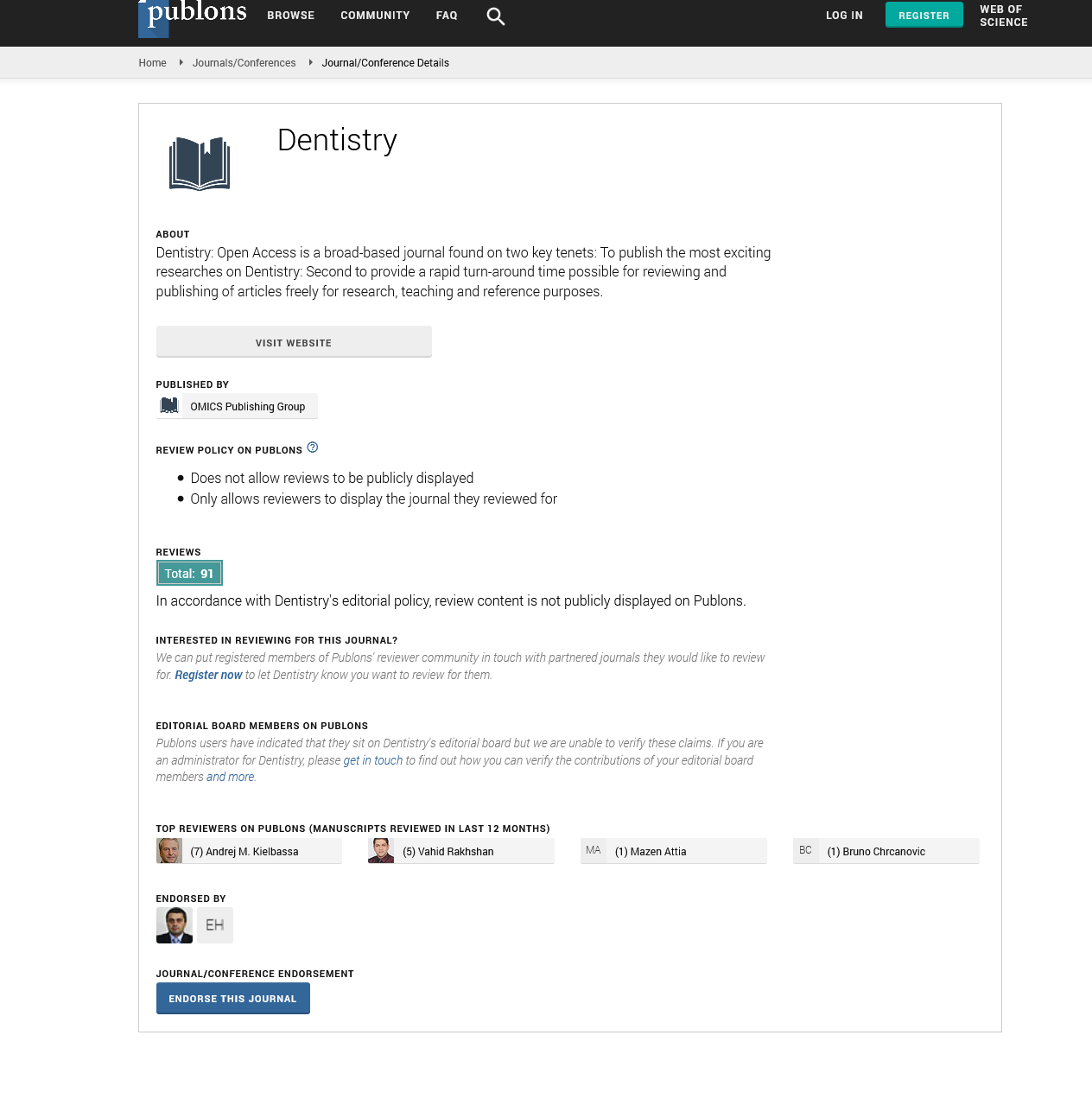Citations : 2345
Dentistry received 2345 citations as per Google Scholar report
Indexed In
- Genamics JournalSeek
- JournalTOCs
- CiteFactor
- Ulrich's Periodicals Directory
- RefSeek
- Hamdard University
- EBSCO A-Z
- Directory of Abstract Indexing for Journals
- OCLC- WorldCat
- Publons
- Geneva Foundation for Medical Education and Research
- Euro Pub
- Google Scholar
Useful Links
Share This Page
Journal Flyer

Open Access Journals
- Agri and Aquaculture
- Biochemistry
- Bioinformatics & Systems Biology
- Business & Management
- Chemistry
- Clinical Sciences
- Engineering
- Food & Nutrition
- General Science
- Genetics & Molecular Biology
- Immunology & Microbiology
- Medical Sciences
- Neuroscience & Psychology
- Nursing & Health Care
- Pharmaceutical Sciences
Opinion Article - (2024) Volume 14, Issue 2
Development and Significance of Cosmetic Dentistry: Increasing Self-Assurance
Arthur Heller*Received: 03-Jun-2024, Manuscript No. DCR-24-26160; Editor assigned: 05-Jun-2024, Pre QC No. DCR-24-26160 (PQ); Reviewed: 19-Jun-2024, QC No. DCR-24-26160; Revised: 26-Jun-2024, Manuscript No. DCR-24-26160 (R); Published: 03-Jul-2024, DOI: 10.35248/2161-1122.23.14.690
Description
Cosmetic dentistry has developed as a vital field in dental care, focusing not just on oral health, but also on the aesthetic improvement of teeth and smiles. Over the past few times, there has been a significant change in the perception and importance of dental aesthetic. Dentistry was primarily concerned with the prevention and treatment of oral diseases. However, the aesthetic aspect of dental care has gained importance since the late 20th century. Advances in dental technology and materials have played an important role in this evolution. Techniques that were once complex and expensive have become more accessible and affordable, making cosmetic dentistry an integral part of general dental practices. Cosmetic dentistry includes a wide range of procedures, each designed to address specific aesthetic concerns. The most common procedures include teeth whitening, veneers, dental bonding, dental implants, and orthodontics. Teeth can become stained or discolored due to various factors such as smoking, coffee, tea, or certain medications. Teeth whitening procedures use bleaching agents to lighten the color of the teeth, enhancing their appearance.
Veneers are thin shells made of porcelain or composite resin that are custom-made to fit over the front surface of the teeth. They are used to cover a range of dental imperfections such as chips, cracks, gaps, and discoloration. Veneers provide a natural tooth appearance and are resistant to staining, making them a durable option for improving smiles. This procedure involves applying a tooth-colored resin to the teeth, which is then hardened with a special light. Dental bonding is used to repair chipped or cracked teeth, close gaps, and change the shape of teeth. It is a cost-effective solution compared to other cosmetic procedures and can often be completed in a single visit.
Implants consist of a titanium post that is surgically placed into the jawbone, providing a strong foundation for a replacement tooth. Dental implants not only improve the appearance of the smile but also restore functionality, allowing individuals to eat and speak comfortably. While traditionally associated with children and teenagers, orthodontic treatments are now widely sought by adults as well. Braces and clear aligners such as Invisalign are used to correct misaligned teeth, bites, and jaw positions. These treatments can significantly improve the aesthetics of the smile while also contributing to better oral health. The benefits of cosmetic dentistry extend beyond the obvious improvement in appearance. A beautiful smile can have profound effects on an individual's self-esteem and confidence. Studies have shown that people who are satisfied with their smiles are more likely to engage in social activities, perform better in professional settings, and experience overall greater life satisfaction.
The psychological benefits of cosmetic dentistry are substantial. Feeling self-conscious about one's teeth can lead to social anxiety and a reluctance to smile or speak in public. By addressing these concerns, cosmetic dentistry can help individuals feel more comfortable and confident in social interactions. For example, straightening misaligned teeth with orthodontics can make brushing and flossing easier, reducing the risk of cavities and gum disease. Similarly, dental implants prevent bone loss in the jaw, which can occur when teeth are missing. Modern cosmetic dental treatments offer durable results. Materials such as porcelain used in veneers and crowns are designed to withstand the daily wear and tear of chewing and speaking. With proper care and maintenance, these enhancements can last for many years, providing long-term satisfaction. While cosmetic dentistry offers numerous benefits, it is essential to consider the potential risks and limitations. Not all procedures are suitable for everyone, and a thorough consultation with a qualified cosmetic dentist is necessary to determine the best course of action. Some procedures may require multiple visits and involve a recovery period. As with any medical procedure, there are potential complications associated with cosmetic dentistry. For example, teeth whitening can cause temporary tooth sensitivity, and dental implants require a surgical procedure that carries inherent risks. It is crucial to follow the dentist's post-procedure care instructions to minimize these risks.
Maintaining the results of cosmetic dental treatments often commitment to good oral hygiene practices. Regular dental check-ups, proper brushing and flossing, and avoiding foods and beverages that can stain teeth are essential to preserving the appearance of cosmetic enhancements. The future of cosmetic dentistry looks promising with ongoing advancements in technology and materials. Digital dentistry, including 3D printing and CAD/CAM (computer-aided design and computer-aided manufacturing), is revolutionizing the way dental restorations are created and fitted. These technologies allow for more precise and customized treatments, enhancing both the functionality and aesthetics of dental work. Moreover, the development of new materials that have the natural properties of tooth enamel is expected to improve the durability and appearance of cosmetic dental treatments. Bio compatible materials that integrate seamlessly with natural tissues are being explored, which could lead to even more natural-looking results. Cosmetic dentistry has become an essential part of modern dental care, offering solutions that enhance both the appearance and functionality of teeth. From teeth whitening to dental implants, these procedures provide individuals with the opportunity to improve their smiles and boost their confidence. While the benefits are substantial, it is important to approach cosmetic dentistry with careful consideration and professional guidance. The field of cosmetic dentistry has potential for even more successful and aesthetically beautiful procedures as technology develops.
Citation: Heller A (2024) Development and Significance of Cosmetic Dentistry: Increasing Self-Assurance. J Dentistry. 14:690.
Copyright: © 2024 Heller A. This is an open access article distributed under the terms of the Creative Commons Attribution License, which permits unrestricted use, distribution, and reproduction in any medium, provided the original author and source are credited.

